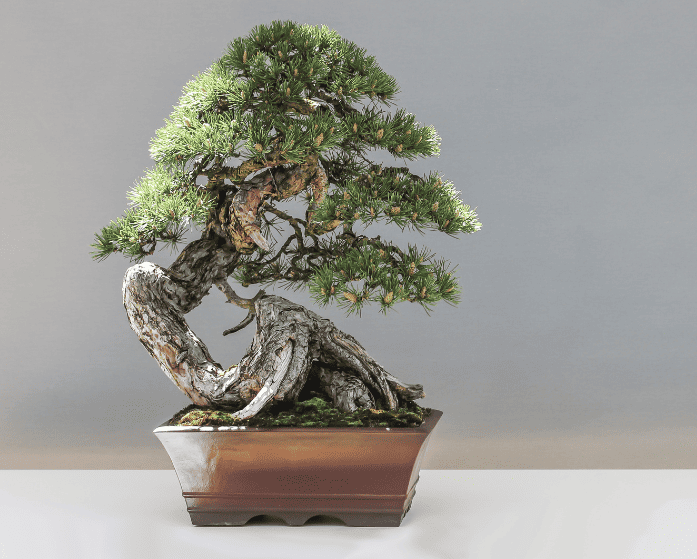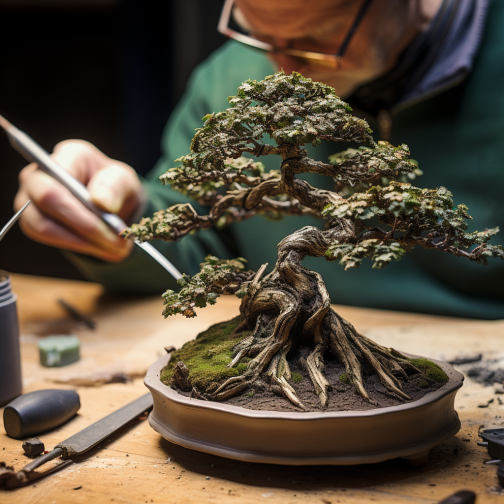Bonsai trees are fascinating miniature versions of full-sized trees that require careful attention and maintenance to thrive. One of the essential techniques used to shape and design bonsai trees is wiring. Bonsai wiring is the process of wrapping wire around the branches and trunk of a tree to bend and shape them into a desired form.
Wiring is a crucial technique in bonsai art, as it allows for the creation of intricate designs and shapes that would not be possible otherwise. The wire used in bonsai wiring is typically made of copper or aluminum and comes in various gauges depending on the size and strength of the branches being wired. Copper wire is preferred for its flexibility and ability to hold its shape, while aluminum wire is better suited for more delicate branches.
Mastering bonsai wiring requires patience, skill, and knowledge of the principles behind advanced wiring techniques. Timing is also critical, as wiring should be done during the tree’s growth season and removed before it cuts into the bark. With the right tools, techniques, and troubleshooting tips, anyone can learn to create stunning and complex bonsai designs. This article will explore the various bonsai wiring techniques used to create artful designs and provide tips for achieving beautiful results.
Understanding Bonsai Wiring Fundamentals
Bonsai wiring is a technique used to shape and train the branches and trunk of a bonsai tree. This technique involves wrapping wire around the branches and trunk to manipulate their growth and create a desired shape. Understanding the fundamentals of bonsai wiring is essential for creating artful designs.
Purpose of Wiring in Bonsai
Wiring in bonsai aims to create a desired shape and structure for the tree. By wrapping wire around the branches and trunk, bonsai enthusiasts can guide the tree’s growth and create a specific design. Wiring is typically done during the tree’s dormant season when the branches are more flexible and easier to manipulate.
Types of Wire
Two main types of wire are used in bonsai wiring: copper and aluminum. Copper wire is commonly used because it is flexible and holds its shape well. However, removing once the tree has grown around it can be difficult. Aluminum wire is also suitable for bonsai wiring, especially for more delicate branches. Anodized aluminum wire is popular because it is easy to see against the bark and does not corrode over time.
Selecting the Right Wire for Your Bonsai
Selecting the right wire for your bonsai is essential for successful wiring. The wire should be strong enough to hold the branch in place but not so thick that it damages the bark or branches. The gauge of the wire depends on the size and strength of the branches being wired. It is recommended to use annealed copper wire for larger branches and thinner wire for smaller branches. The wire thickness should be about one-third the diameter of the wired branch.
In summary, understanding the fundamentals of bonsai wiring is essential for creating artful designs. Copper wire and aluminum wire are the two main types of wire used in bonsai wiring, and selecting the right wire for your bonsai is crucial for successful wiring. Bonsai enthusiasts can create beautiful and artistic designs with their trees by following these guidelines.
Preparation for Wiring
Bonsai wiring is a technique that shapes and trains bonsai trees into artful designs. Before starting with bonsai wiring, preparing the necessary tools and assessing the tree structure is essential. This section covers the steps required for preparation before wiring.
Tools Required for Wiring
Wiring bonsai trees requires specific tools that help in bending and wrapping the wire around the branches. The essential tools required for wiring include wire cutters and pliers. Wire cutters are used to cut the wire to the required length, and pliers help twist the wire around the branches.
Assessing Tree Structure Before Wiring
Before wiring, it is crucial to assess the tree structure to determine the branches that require wiring. The branches that need wiring should be flexible enough to bend without breaking. Assessing the tree structure also helps in determining the thickness of the wire required for wiring. Using a wire that is too thick or too thin can damage the tree.
Timing and Bonsai Tree Care
In bonsai tree care, timing plays a pivotal role in the success of various techniques, with wiring no exception. The optimal time for wiring bonsai trees is during the growing season when the tree is in an active phase of growth. Wiring during this period makes the branches more pliable, making it easier to shape them without causing undue stress. The tree’s metabolic activity and vigorous growth during the growing season enhance its ability to heal and recover from the adjustments made through wiring.
Conversely, attempting to wire a bonsai during the dormant season, when the tree is not actively growing, is ill-advised. During dormancy, the tree is in a state of rest, and its reduced physiological activity makes it more vulnerable to stress and potential damage. Wiring during this period can lead to harm, as the tree lacks the vitality needed to respond and recover effectively.
Equally crucial is the timely removal of the wire once the shaping objectives have been achieved. Leaving the wire on the tree for an extended duration can result in the wire biting into the bark as the tree continues to grow. This can cause scarring and potentially compromise the health of the bonsai. Regular monitoring and timely removal of the wire help prevent such issues, ensuring that the tree continues to thrive without being hindered by the very technique designed to enhance its aesthetic form.
In essence, understanding and respecting the natural rhythms of the bonsai tree, aligning activities like wiring with its active growth periods, and implementing timely practices are fundamental aspects of successful bonsai care. The careful consideration of timing ensures the tree’s health and resilience and contributes to the bonsai shaping process’s overall success and longevity.
Wiring Bonsai for Beginners
Bonsai wiring is an essential technique for shaping and designing a bonsai tree. It is a delicate process that requires patience and skill. For beginners, it can be overwhelming to get started with bonsai wiring. However, with the right tools and techniques, anyone can learn to wire a bonsai tree.
Step-by-Step Guide for First-Time Wiring
The first step in wiring a bonsai tree is to choose the right wire. Aluminum wire is commonly used for most bonsai trees because it is strong enough to hold the branches in place but also flexible enough to be shaped without causing damage. Once you have the right wire, you need to determine the direction you want the branch or trunk to take.
Next, you need to wrap the wire around the branch or trunk. Always start from the thickest part of your tree and work your way upward and out. Coil twice around the base and continue up the trunk. When wiring branches, always wrap the wire twice around the trunk and work your way to the tips. This applies to both double- and single-wiring.
Once the wire is in place, you need to bend the branch or trunk in the desired direction. Be gentle and avoid applying too much pressure, which can damage the tree. After bending, you must secure the wire by twisting the ends together.
Choosing the Right Time to Wire
It is important to choose the right time to wire your bonsai tree. The best time to wire a tree is during the growing season, which is usually in the spring or early summer. During this time, the tree is actively growing, and the branches are more flexible and easier to bend.
It is important to avoid wiring your tree during the dormant season, which is usually in the winter. During this time, the tree is not actively growing, and the branches are more brittle and prone to damage.
Basic Care for Juvenile Bonsai
Juvenile bonsai trees require special care when it comes to wiring. They are delicate and can easily be damaged if not handled properly. It is important to avoid wiring very young trees, as they are still developing and need time to grow.
When wiring juvenile bonsai trees, it is important to be gentle and avoid applying too much pressure. You should also avoid wiring the same branch or trunk more than once in the growing season, as this can damage the tree.
In conclusion, wiring a bonsai tree is a delicate process that requires patience and skill. By following the step-by-step guide for first-time wiring, choosing the right time to wire, and providing basic care for juvenile bonsai, beginners can learn to wire a bonsai tree with confidence and create artful designs.
Wiring Techniques and Application
Bonsai wiring is a technique used to shape and train a tree’s branches into a desired form. It involves wrapping wire around the branches and bending them into the desired position. This technique is essential to create artful designs and is used by bonsai enthusiasts worldwide.
Basic Wiring Technique
The basic wiring technique involves wrapping wire around a branch and bending it into the desired position. The wire should be wrapped around the branch at a 45-degree angle and should be tight enough to hold the branch in place but not too tight to cause damage. It is important to choose the right wire for the job. Aluminum wire is commonly used for most bonsai trees because it is strong enough to hold the branches in place but also flexible enough to be shaped without causing damage.
Wiring Angles and Direction
When wiring a branch, it is important to consider the angle and direction of the wire. The wire should be wrapped around the branch at a 45-degree angle in the direction that you want the branch to grow. This will help to create a natural-looking bend in the branch.
Wiring Primary and Secondary Branches
When wiring a bonsai tree, it is important to wire the primary branches first. These are the larger branches that form the tree’s structure. Once the primary branches are wired, the secondary branches can be wired to create a more intricate design. It is important to wire the branches in a way that creates a balanced and natural-looking design.
Double Wiring and Coiling Methods
Double wiring is a technique used to wire two branches together to create a more intricate design. This technique is often used when creating a bonsai tree with multiple trunks. Coiling is another technique used to create intricate designs. It involves wrapping wire around a branch and then coiling it back on itself to create a loop. This technique is often used when creating bonsai trees with a more complex design.
In conclusion, bonsai wiring is a technique used to shape and train a tree’s branches into a desired form. It involves wrapping wire around the branches and bending them into the desired position. The basic wiring technique involves wrapping wire around a branch at a 45-degree angle and choosing the right wire for the job. When wiring a branch, it is important to consider the angle and direction of the wire. Wiring primary and secondary branches in a way that creates a balanced and natural-looking design is essential. Double wiring and coiling methods are often used to create more intricate designs.
Advanced Wiring Strategies
Bonsai wiring is a crucial technique for shaping and training bonsai trees into beautiful and intricate forms. Advanced wiring techniques are essential for creating artful designs that stand out from the rest.
Structural Wiring for Tree Design
Structural wiring is a technique that involves wrapping wire around the trunk and branches of a bonsai tree to create a desired shape and style. This technique is commonly used for deciduous trees, which have a more flexible structure than conifers. By wrapping wire around the trunk and branches at the right angle and tension, the artist can control the growth and direction of the tree.
To achieve the desired shape, the artist must also consider the thickness and length of the branches. For example, if the artist wants to create a tree with a slanting trunk, they must wire the branches in a way that complements the slant of the trunk. Additionally, the artist must also consider the overall balance and proportion of the tree.
Wiring Deciduous Trees vs. Conifers
Wiring deciduous trees and conifers requires different techniques due to their different structures. Deciduous trees have a more flexible structure, making them easier to wire. In contrast, conifers have a more rigid structure, making them more difficult to wire.
When wiring deciduous trees, the artist must consider the timing of the wiring. The best time to wire deciduous trees is during the dormant season, which is usually in the late winter or early spring. This is because the tree is less likely to be damaged when it is not actively growing.
On the other hand, wiring conifers require a more delicate touch. The artist must use thinner wire and be careful not to damage the tree’s needles. Additionally, the artist must also consider the timing of the wiring. The best time to wire conifers is during the growing season, which is usually in the spring or early summer. This is because the tree is more flexible during this time and less likely to be damaged.
Overall, advanced wiring techniques are essential for creating artful designs in bonsai trees. By using structural wiring and understanding the differences between wiring deciduous trees and conifers, the artist can create stunning designs that showcase their artistry and technique.
Maintaining and Monitoring Wired Bonsai

Once the bonsai tree has been wired, it is important to maintain and monitor it regularly to ensure its health and prevent any damage. This section will cover two important aspects of maintaining and monitoring wired bonsai: regular maintenance and adjustments, and recognizing and preventing wire bite.
Regular Maintenance and Adjustments
Wired bonsai trees require regular maintenance and adjustments to ensure that the wire does not bite into the bark and cause scars or pressure on the branches. The wire must be checked every few weeks to ensure that it is not too tight or too loose. If the wire is too tight, it can cause pressure on the branch, while if it is too loose, it will not hold the branch in place.
To maintain the shape of the bonsai tree, the wire must be adjusted as the tree grows. This involves loosening the wire and repositioning it to accommodate the new growth. If the wire is not adjusted, it can bite into the bark and cause scars or pressure on the branches.
Recognizing and Preventing Wire Bite
Wire bite is a common problem with wired bonsai trees. It occurs when the wire bites into the bark of the tree, causing scars or pressure on the branches. Wire bites can be recognized by the appearance of scars or marks on the bark of the tree.
To prevent wire bites, it is important to check the wire regularly and adjust it as necessary. The wire should be removed before it bites into the bark, and the branch should be allowed to rest for a few weeks before rewiring. It is also important to use the right gauge wire for the size of the branch. If the wire is too thin, it will not hold the branch in place, while if it is too thick, it will bite into the bark.
Overall, maintaining and monitoring wired bonsai trees is crucial for their health and beauty. With regular maintenance and adjustments, and by recognizing and preventing wire bites, bonsai enthusiasts can create artful designs that will thrive for years to come.
Removing Wire and Aftercare

Safely Removing Wire
Removing the wire from a bonsai is a delicate process that requires careful attention to avoid damaging the tree. It is best to remove the wire before it cuts into the bark or leaves marks on the branches. The wire should be removed when the branches have set in the desired shape.
To remove the wire, use wire cutters with a rounded head. Cut the wire at short, regular intervals so it more or less drops off the tree. If the wire has already started to cut into the branch, unwinding the wire can cause further damage. In this case, cut the wire at the point where it enters the branch and gently remove the wire.
Healing and Protecting the Bonsai After Wiring
After removing the wire, it is important to take steps to help the bonsai recover from the wiring process. The branches may have been under stress during the wiring process, and removing the wire can cause additional stress. To help the bonsai heal and protect it from further damage, consider the following aftercare tips:
- Cover the wound with raffia or tape to protect the bark from damage.
- Keep the bonsai in a shaded area for a few days after wiring to reduce stress.
- Water the bonsai regularly to keep the soil moist and help the tree recover faster.
- Avoid pruning or trimming the bonsai for a few weeks after wiring to give the tree time to recover.
By following these aftercare tips, the bonsai will have a better chance of recovering from the wiring process and growing healthy and strong.
Troubleshooting Common Wiring Issues

When working with bonsai wiring techniques, there are a few common issues that may arise. Here are some tips to help troubleshoot these issues.
Correcting Mistakes in Wiring
Mistakes can happen when wiring a bonsai tree, especially for beginners. If a mistake is made, it is important to correct it as soon as possible to avoid any damage to the tree. One common mistake is wiring too tightly, which can cause damage to the bark or branches. To fix this, gently loosen the wire using pliers or fingers.
Another mistake is wiring too loosely, which can cause the wire to slip off the branch. To fix this, simply tighten the wire by twisting it with pliers. It is also important to ensure that the wire is wrapped in a spiral around the branch and not in a straight line. This will help to provide more support and prevent the wire from slipping.
Addressing Overgrown Branches
Overgrown branches can be a challenge when it comes to wiring a bonsai tree. If the branch is too thick or stiff, it may be difficult to bend it into the desired shape. In this case, it may be necessary to prune the branch before wiring it.
Before pruning, it is important to assess the tree’s overall design and determine which branches need to be removed. Once the pruning is complete, the remaining branches can be wired into the desired shape. It is important to use the proper wiring technique and ensure that the wire is flexible enough to allow for movement without causing damage to the tree.
In summary, when troubleshooting wiring issues, it is important to consider the proper wiring technique, flexibility, movement, and pruning. By following these tips, bonsai enthusiasts can create artful designs and maintain the health of their trees.
Creative Aspects of Bonsai Wiring

Bonsai wiring is not just a technique to shape a tree but also an art form that requires finesse, balance, and artistry. The creative aspects of bonsai wiring involve the artist’s ability to envision the final design and then use the wire to shape the tree to that vision.
One of the aesthetic aspects of bonsai wiring is the ability to create movement in the tree. The artist can use the wire to create a sense of flow, making the tree appear as if it is bending or swaying in the wind. This movement can be used to create a sense of dynamism in the tree, making it appear more alive and vibrant.
Another creative aspect of bonsai wiring is the ability to create balance in the tree. The artist can use the wire to adjust the balance of the tree, making it appear more stable and grounded. This balance can be used to create a sense of harmony in the tree, making it appear more pleasing to the eye.
The artistry of bonsai wiring involves the artist’s ability to use the wire to create intricate designs and patterns in the tree. This can be done by wrapping the wire around the branches in a specific way, creating a sense of texture and depth in the tree. The artist can also use different types of wire, such as copper or aluminum, to create different effects in the tree.
Overall, bonsai wiring is a creative process that requires skill, patience, and a keen eye for detail. The artist must be able to envision the final design and then use the wire to shape the tree to that vision. By incorporating movement, balance, and artistry into the wiring process, the artist can create a stunning and unique work of art.
Conclusion
In conclusion, mastering the art of bonsai wiring requires patience, practice, and confidence. With the right knowledge of wiring techniques, one can create stunning bonsai trees that showcase their artistic vision.
It is important to keep in mind that wiring should be done with care, as improper wiring can damage the tree. By using the right type and thickness of wire, one can guide the growth of the branches and create the desired aesthetic form.
One should also be aware of the right time to wire the tree, as wiring at the wrong time can cause damage to the tree. It is recommended to wire deciduous trees in the late winter or early spring, while conifers can be wired in the fall or winter.
Overall, bonsai wiring is a crucial aspect of bonsai art and requires a deep understanding of the techniques involved. By following the guidelines mentioned above, one can develop the necessary skills to create beautiful bonsai designs.


